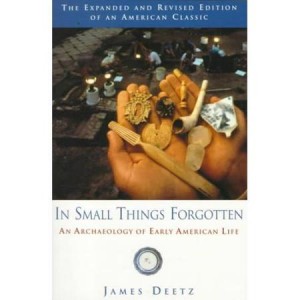
As humanity prepares to bid farewell to this all-around sucker-punch of a year, you are going to see a lot of “Best of 2016” (and “Worst of 2016”) lists floating around. But none, I promise you, is quite like the Peabody Library’s Best of 2016 List. We asked our staff to share with us–and you–their favorite books, films, albums, or other Library materials that they encountered this year. The response was so terrific that we’ll be running a weekly series for your enjoyment.
And, just a note, the rules were that the media had to be consumed in 2016 (books read, films viewed, albums heard, etc.), but that doesn’t mean that they were made in 2016. There are some classics on this list, as well as plenty of new material, so you can see all the phenomenal finds the Library has to offer year round!
And so, let’s begin!

From the West Branch:
The Summer Before the War by Helen Simonson
“…delightful, funny and sad. I didn’t want it to end!”
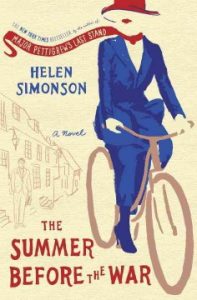 East Sussex, 1914. It is the end of England’s brief Edwardian summer, and everyone agrees that the weather has never been so beautiful. Hugh Grange, down from his medical studies, is visiting his Aunt Agatha, who lives with her husband in the small, idyllic coastal town of Rye. Agatha’s husband works in the Foreign Office, and she is certain he will ensure that the recent saber rattling over the Balkans won’t come to anything. And Agatha has more immediate concerns; she has just risked her carefully built reputation by pushing for the appointment of a woman to replace the Latin master. When Beatrice Nash arrives with one trunk and several large crates of books, it is clear she is significantly more freethinking — and attractive — than anyone believes a Latin teacher should be. For her part, mourning the death of her beloved father, who has left her penniless, Beatrice simply wants to be left alone to pursue her teaching and writing. But just as Beatrice comes alive to the beauty of the Sussex landscape and the colorful characters who populate Rye, the perfect summer is about to end. For despite Agatha’s reassurances, the unimaginable is coming. Soon the limits of progress, and the old ways, will be tested as this small Sussex town and its inhabitants go to war.
East Sussex, 1914. It is the end of England’s brief Edwardian summer, and everyone agrees that the weather has never been so beautiful. Hugh Grange, down from his medical studies, is visiting his Aunt Agatha, who lives with her husband in the small, idyllic coastal town of Rye. Agatha’s husband works in the Foreign Office, and she is certain he will ensure that the recent saber rattling over the Balkans won’t come to anything. And Agatha has more immediate concerns; she has just risked her carefully built reputation by pushing for the appointment of a woman to replace the Latin master. When Beatrice Nash arrives with one trunk and several large crates of books, it is clear she is significantly more freethinking — and attractive — than anyone believes a Latin teacher should be. For her part, mourning the death of her beloved father, who has left her penniless, Beatrice simply wants to be left alone to pursue her teaching and writing. But just as Beatrice comes alive to the beauty of the Sussex landscape and the colorful characters who populate Rye, the perfect summer is about to end. For despite Agatha’s reassurances, the unimaginable is coming. Soon the limits of progress, and the old ways, will be tested as this small Sussex town and its inhabitants go to war.
From the Upstairs Offices:
The Yamas and Niyamas by Deborah Adele
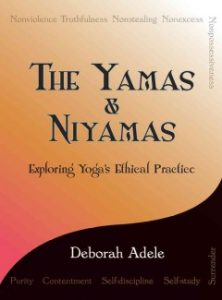 “The Yamas and Niyamas are the ten ethical foundations of yoga. Adele devotes a chapter to each Yama and Niyama that includes clear examples and explanations of the concepts followed by a series of questions to help readers spend time deeply exploring each principle. Whether you’re a yogi looking to deepen your practice, or someone who just wants to expand your way of living and thinking, you’ll find lots to think about here.”
“The Yamas and Niyamas are the ten ethical foundations of yoga. Adele devotes a chapter to each Yama and Niyama that includes clear examples and explanations of the concepts followed by a series of questions to help readers spend time deeply exploring each principle. Whether you’re a yogi looking to deepen your practice, or someone who just wants to expand your way of living and thinking, you’ll find lots to think about here.”
The first two limbs of the eight-fold path of yoga sutras—the basic text for classical yoga—are examined in this spiritual guide to the practice of yoga. Foundational to all yogic thought, they are considered to be the guidelines to the yoga way of living that free individuals to take ownership of their lives, direct them toward the fulfillment they seek, and gain the skills to choose attitude, thought, and action. The first five guidelines are referred to as the yamas—a Sanskrit word that translates to “restraints”—and encompass nonviolence, truthfulness, not stealing, nonexcess, and nonpossessiveness. The last five are referred to as the niyamas, or observances—purity, contentment, self-discipline, self-study, and surrender. A self-study section at the end of each chapter may also be used by instructors for group discussion.
From the South Branch:
Bitter Greens by Kate Forsyth
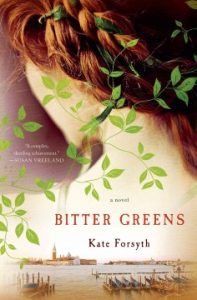 “I’m a sucker for retold fairy tales and Forsyth’s take on Rapunzel was particularly well done. Forsyth’s prose is gorgeous as she weaves in historical facts with fairy tale and original ideas. It was reminiscent of my favorite Gregory Maguire books but with a style all its own.”
“I’m a sucker for retold fairy tales and Forsyth’s take on Rapunzel was particularly well done. Forsyth’s prose is gorgeous as she weaves in historical facts with fairy tale and original ideas. It was reminiscent of my favorite Gregory Maguire books but with a style all its own.”
French novelist Charlotte-Rose de la Force has been banished from the court of Versailles by the Sun King, Louis XIV, after a series of scandalous love affairs. At the convent, she is comforted by an old nun, Sœur Seraphina, who tells her the tale of a young girl who, a hundred years earlier, is sold by her parents for a handful of bitter greens…
After Margherita’s father steals parsley from the walled garden of the courtesan Selena Leonelli, he is threatened with having both hands cut off, unless he and his wife relinquish their precious little girl. Selena is the famous red-haired muse of the artist Tiziano, first painted by him in 1512 and still inspiring him at the time of his death. She is at the center of Renaissance life in Venice, a world of beauty and danger, seduction and betrayal, love and superstition. Locked away in a tower, Margherita sings in the hope that someone will hear her. One day, a young man does.
Award-winning author Kate Forsyth braids together the stories of Margherita, Selena, and Charlotte-Rose, the woman who penned Rapunzel as we now know it, to create what is a sumptuous historical novel, an enchanting fairy tale retelling, and a loving tribute to the imagination of one remarkable woman.
From the Reference Desk:
In Cold Blood by Truman Capote (Read By Scott Brick)
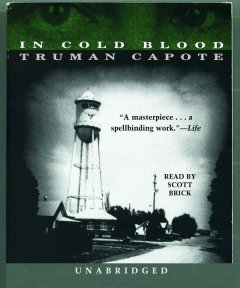 “I knew about this book from films that were made about it a few years back, but nothing could prepare me for the haunting narrative that Capote put together. His sympathy and ruthless attention to detail bring every detail of this crime, of its victims, and, especially, of its perpetrators, to life in a way that is uncomfortable, fascinating, and surprisingly modern. Scott Brick’s pitch-perfect narration gives extra life to the characters, and emphasizes the lingering effects of violence on all who are touched by it.”
“I knew about this book from films that were made about it a few years back, but nothing could prepare me for the haunting narrative that Capote put together. His sympathy and ruthless attention to detail bring every detail of this crime, of its victims, and, especially, of its perpetrators, to life in a way that is uncomfortable, fascinating, and surprisingly modern. Scott Brick’s pitch-perfect narration gives extra life to the characters, and emphasizes the lingering effects of violence on all who are touched by it.”
On November 15, 1959, in the small town of Holcomb, Kansas, four members of the Clutter family were savagely murdered by blasts from a shotgun held a few inches from their faces. There was no apparent motive for the crime, and there were almost no clues.
As Truman Capote reconstructs the murder and the investigation that led to the capture, trial, and execution of the killers, he generates both mesmerizing suspense and astonishing empathy. In Cold Blood is a work that transcends its moment, yielding poignant insights into the nature of American violence.

